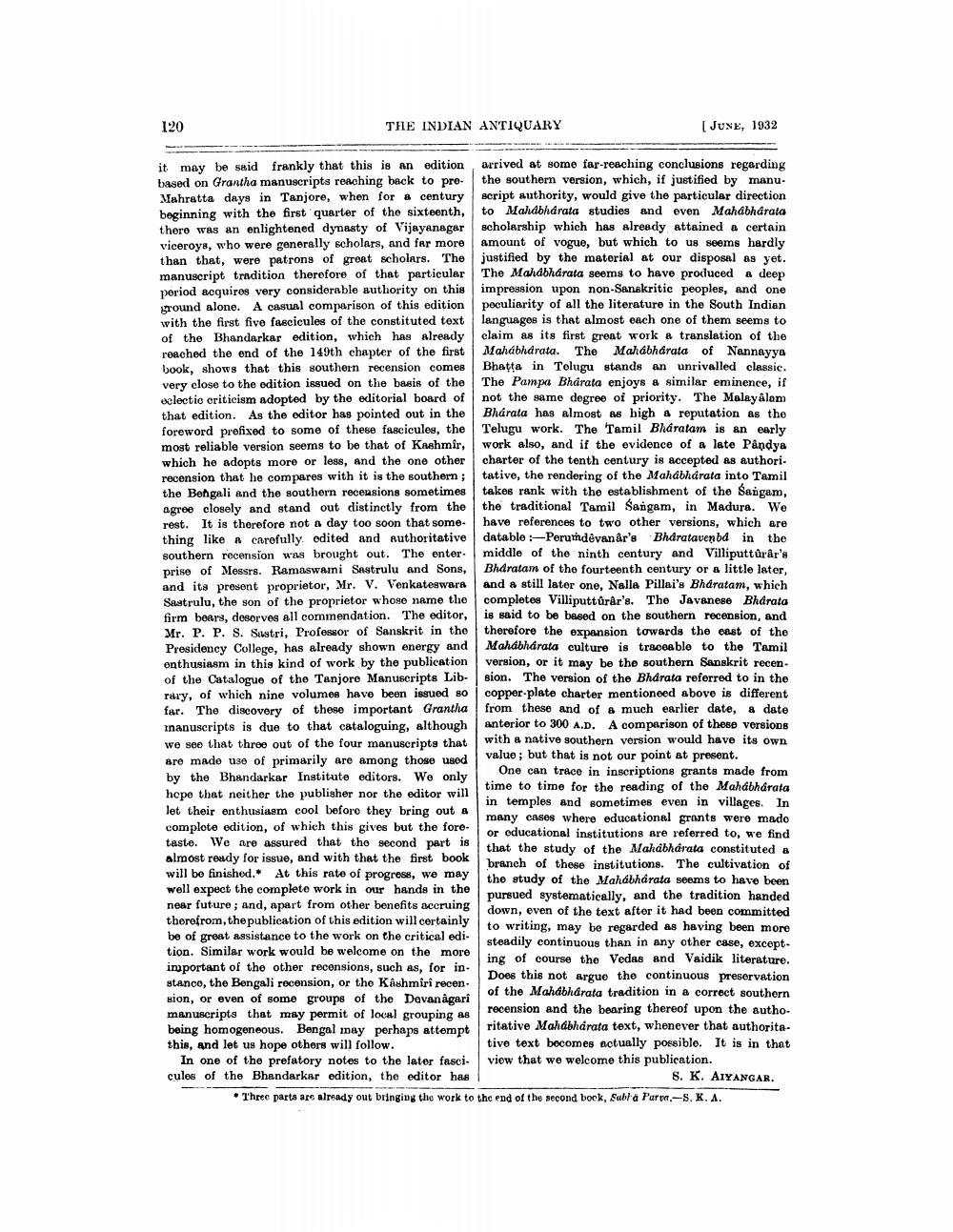________________
120
THE INDIAN ANTIQUARY
[ JUNE, 1932
it may be said frankly that this is an edition, arrived at some far-reaching conclusions regarding based on Grantha manuscripts reaching back to pre- the southern version, which, if justified by manuMahratta days in Tanjore, when for a century script authority, would give the particular direction beginning with the first quarter of the sixteenth, to Mahdbhdrata studies and even Mahabharata thero was an enlightened dynasty of Vijayanagar scholarship which has already attained a certain viceroys, who were generally scholars, and for more amount of vogue, but which to us seems hardly than that, were patrons of great scholars. The justified by the material at our disposal as yet. manuscript tradition therefore of that particular The Mahdhdrata seems to have produced a deep period aoquiros very considerable authority on this impression upon non-Sanskritic peoples, and one ground alone. A casual comparison of this edition peculiarity of all the literature in the South Indian with the first five fascicules of the constituted text languages is that almost each one of them seems to of the Bhandarkar edition, which has already claim as its first great work a translation of the reached the end of the 149th chapter of the first Mahábhdrata. The Mahabharata of Nannayya book, shows that this southern recension comes Bhatta in Telugu stands an unrivalled classic. very close to the edition issued on the basis of the The Pampa Bharata enjoys a similar eminence, if selectie criticism adopted by the exitorial board of not the same degree of priority. The Malayalam that edition. As the editor has pointed out in the Bharata has almost as high a reputation as the foreword prefixed to some of these fascicules, the Telugu work. The Tamil Bharatam is an early most reliable version seems to be that of Kashmir, work also, and if the evidence of a late Pandya which he adopts more or less, and the one other charter of the tenth century is accepted as authori. recension that he compares with it is the southern ; tative, the rendering of the Mahabharata into Tamil the Bengali and the southern recensions sometimes takes rank with the establishment of the Sangam, agree closely and stand out distinctly from the the traditional Tamil Sangam, in Madura. We rest. It is therefore not a day too soon that some. have references to two other versions, which are thing like A carefully edited and authoritative datable :-Perundêvanêr's Bhdratavenbd in the southern recension was brought out. The enter. middle of the ninth century and Villiputtûrâr's prise of Messrs. Ramaswami Sastrulu and Sons, Bharatam of the fourteenth century or a little later, and ita present proprietor, Mr. V. Venkateswara and a still later one, Nalla Pillai's Bharatam, which Sastrulu, the son of the proprietor whose name the completes Villiputtúrår's. The Javanese Bhdrata firm bars, dosorves all commendation. The editor, is said to be based on the southern recension, and Mr. P. P. S. Sustri, Professor of Sanskrit in the therefore the expansion towards the cast of the Presidency College, has already shown energy and Mahabharata culture is traooablo to the Tamil enthusiasm in this kind of work by the publication version, or it may be the southern Sanskrit recenof the Catalogue of the Tanjore Manuscripts Lib. sion. The version of the Bhdrata referred to in the rary, of which nine volumes have been issued so copper-plate charter mentioneed above is different far. The discovery of these important Grantha from these and of a much earlier date, & date Inanuscripts is due to that cataloguing, although anterior to 300 A.D. A comparison of these versions we see that three out of the four manuscripts that with a native southern version would have its own are made use of primarily are among those used value, but that is not our point at present. by the Bhandarkar Institute editors. We only
One can trace in inscriptions grants made from hope that neither the publisher nor the editor will
time to time for the reading of the Mahabharata let their enthusiasm cool before they bring out a
in temples and sometimes even in villages. In
many cases where educational grants were mado comploto edition, of which this gives but the fore
or educational institutions are referred to, we find taste. We are assured that the second part is
that the study of the Mahabharata constituted & almost ready for issue, and with that the first book
branch of these institutions. The cultivation of will be finished. At this rate of progress, we may
the study of the Mahabharata seems to have been well expect the complete work in our hands in the
pursued systematically, and the tradition handed near future; and, apart from other benefits accruing
down, even of the text after it had been committed therefrom, the publication of this edition will certainly
to writing, may be regarded as having been more be of great assistance to the work on the critical edi.
steadily continuous than in any other case, except. tion. Similar work would be welcome on the more
ing of course the Vedas and Vaidik literature. important of the other recensions, such as, for in. stanco, the Bengali recension, or the Kashmiri recen.
Does this not argue the continuous preservation Bion, or even of some groups of the Devanagari
of the Mahabharata tradition in a correct southern manuscripts that may permit of local grouping as
recension and the bearing thereof upon the authobeing homogeneous. Bengal may perhaps attempt
ritative Mahabharata text, whenever that authoritathis, and let us hope others will follow.
tive text becomes actually possible. It is in that In one of the prefatory notes to the later fasci. view that we welcome this publication. cules of the Bhandarkar edition, the editor has
S. K. AIYANGAR. • Three parts are already out bringing the work to the end of the second bock, Sulla Parm.-S. K. A.




